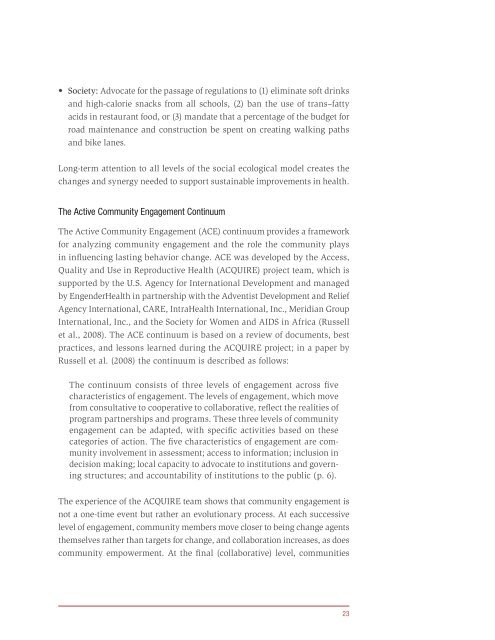Principles of Community Engagement (Second Edition)
Principles of Community Engagement (Second Edition)
Principles of Community Engagement (Second Edition)
You also want an ePaper? Increase the reach of your titles
YUMPU automatically turns print PDFs into web optimized ePapers that Google loves.
• S o c i e t y : Advocate for the passage <strong>of</strong> regulations to (1) eliminate s<strong>of</strong>t drinks<br />
and high-calorie snacks from all schools, (2) ban the use <strong>of</strong> trans–fatty<br />
acids in restaurant food, or (3) mandate that a percentage <strong>of</strong> the budget for<br />
road maintenance and construction be spent on creating walking paths<br />
and bike lanes<br />
Long-term attention to all levels <strong>of</strong> the social ecological model creates the<br />
changes and synergy needed to support sustainable improvements in health<br />
The Active <strong>Community</strong> <strong>Engagement</strong> Continuum<br />
The Active <strong>Community</strong> <strong>Engagement</strong> (ACE) continuum provides a framework<br />
for analyzing community engagement and the role the community plays<br />
in influencing lasting behavior change ACE was developed by the Access,<br />
Quality and Use in Reproductive Health (ACQUIRE) project team, which is<br />
supported by the U S Agency for International Development and managed<br />
by EngenderHealth in partnership with the Adventist Development and Relief<br />
Agency International, CARE, IntraHealth International, Inc , Meridian Group<br />
International, Inc , and the Society for Women and AIDS in Africa (Russell<br />
et al , 2008) The ACE continuum is based on a review <strong>of</strong> documents, best<br />
practices, and lessons learned during the ACQUIRE project; in a paper by<br />
Russell et al (2008) the continuum is described as follows:<br />
The continuum consists <strong>of</strong> three levels <strong>of</strong> engagement across five<br />
characteristics <strong>of</strong> engagement The levels <strong>of</strong> engagement, which move<br />
from consultative to cooperative to collaborative, reflect the realities <strong>of</strong><br />
program partnerships and programs These three levels <strong>of</strong> community<br />
engagement can be adapted, with specific activities based on these<br />
categories <strong>of</strong> action The five characteristics <strong>of</strong> engagement are community<br />
involvement in assessment; access to information; inclusion in<br />
decision making; local capacity to advocate to institutions and governing<br />
structures; and accountability <strong>of</strong> institutions to the public (p 6)<br />
The experience <strong>of</strong> the ACQUIRE team shows that community engagement is<br />
not a one-time event but rather an evolutionary process At each successive<br />
level <strong>of</strong> engagement, community members move closer to being change agents<br />
themselves rather than targets for change, and collaboration increases, as does<br />
community empowerment At the final (collaborative) level, communities<br />
23

















